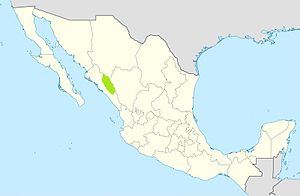Acaxee Rebellion
| Acaxee Rebellion | |||||||
|---|---|---|---|---|---|---|---|
| Part of the Mexican Indian Wars | |||||||
 A map of Mexico showing the location of the Acaxee in Sinaloa and Durango states. |
|||||||
|
|||||||
| Belligerents | |||||||
| Spaniards |
Acaxee Tepehuanos Xiximes |
||||||
The Acaxee Rebellion was an insurrection against Spanish rule in Mexico by Acaxee Indians in 1601.
The Acaxee spoke a Uto-Aztecan language and lived in the mountains, the Sierra Madre Occidental, and canyons of east central Sinaloa and western Durango, east of the city of present-day city of Culiacan. Their territory was about 125 miles north to south and 50 miles east to west. The area was called Topia and Tepehuana by the Spaniards. The Acaxee and their neighbors shared common features of culture identified by scholar Susan M. Deeds as
the cultivation of corn, beans, squash, chilies, and cotton adjacent to small villages and settlements…; frequent warfare with associated ritual cannibalism; polytheism and worship of idols; the presences of shamans or ritual specialists…; and a decentralized political structure that relied on the leadership of elders in peacetime and on war leaders to deal with outsiders.
The dispersed village culture of the Acaxee at the time of the first Spanish contact in the late 16th century may have been the remnant of a more complex hierarchical society that had been decimated by disease earlier in the same century. An epidemic swept the region in 1576-1577, killing many thousands of Indians including possibly many Acaxee, and additional epidemics broke out in 1590 and 1596-1597. Thus, by the time of the rebellion the Acaxee probably numbered only a few thousand. Furthermore, their capacity to resist the Spanish was adversely impacted by their endemic warfare with the Xixime to their south and the Tepehuan to the east.
The Spanish discovered silver deposits in Acaxee territory in the 1580s and established several mining camps. Several hundred Spaniards, black and Indian slaves, and Indian laborers migrated into the Acaxee country. They needed additional labor to work in the mines. Through the Encomienda system the Indians were forced to work in Spanish mines. However, the dispersed nature of the Acaxee settlements was a hindrance to utilizing Indian labor.
Jesuit missionaries assisted in concentrating the Indians in larger settlements for easier exploitation. In the “Peace by Purchase” plan to resolve the Chichimeca War in 1590 the Spanish had recognized the utility of missionaries in the pacification of the northern frontiers of Nueva Espana. The Jesuits were relative newcomers to Mexico and the Indians of Sinaloa and Durango were their first major missionary efforts. In 1600, the missionary Hernando de Santarén toured the region with a local encomendero, Captain Diego de Avila. Together they forced the Acaxee to accede to the demands of the Spaniards which included relocating to where the Spanish told them, building churches, cutting their long hair, wearing clothing, and destroying their religious images and idols. In return, the Spaniards promised to protect them from their enemies and provide tools, seeds, and schools for their communities. Indians who resisted the Spanish demands were beaten.
...
Wikipedia
